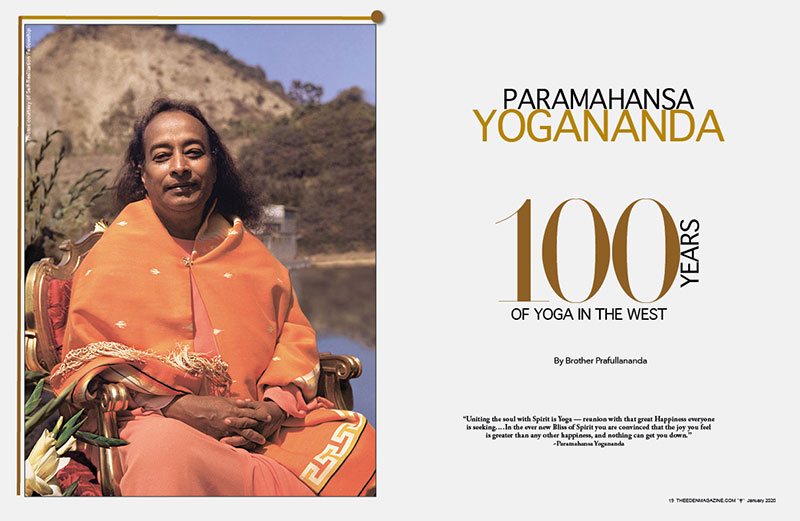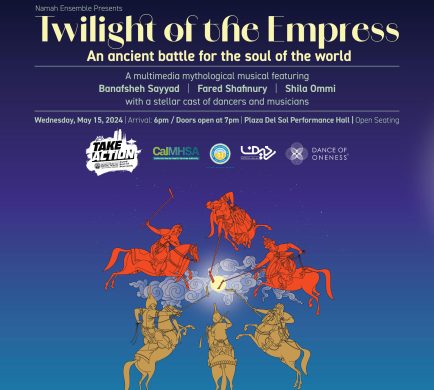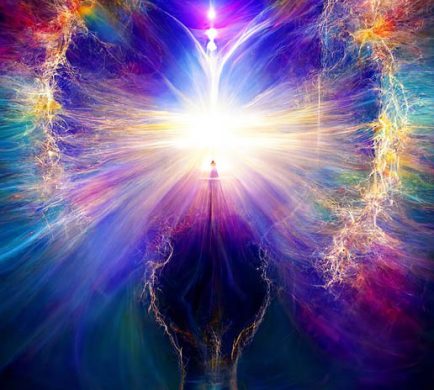By Brother Prafullananda
“Yoga teaches us how to rise above the delusion
of separation and realize
our oneness with God”
It’s Boston harbor in September, 1920 that a young, turbaned swami disembarked from the first postwar steamer arriving in America from India. As the Indian delegate to an International Congress of Religious Liberals soon to convene in Boston, Paramahansa Yogananda’s arrival marked the beginning of a profound change in the spiritual landscape of America — a change that decades later would result in the recognition of Yogananda as the ‘father of Yoga in the West.’
During his first lecture in Boston, Yogananda introduced Westerners to an unconventional and novel concept of the Divine: that God — so often conceived as a venerable Personage, adorning a throne in some antiseptic corner of the cosmos — can be experienced as ever-existing, ever-conscious, ever-new Bliss. He then explicated a step-by-step methodology by which anyone can experience that Bliss for themselves: Yoga meditation, India’s universal science of the soul.
Yogananda’s pioneering efforts sparked an interest in meditation that has deepened over the decades, providing significant impetus to the meditation practiced today by more than 18 million Americans and countless others throughout the world. The year 2020 marks the 100th anniversary of Paramahansa Yogananda’s arrival in the U.S. and the founding of his society, Self-Realization Fellowship (SRF), which he established to disseminate India’s universal and timeless science of yoga meditation.
“Yoga teaches us how to rise above the delusion of separation and realize our oneness with God,” Yogananda stated. “The poet Milton wrote of the soul of man and how it might regain paradise. That is the purpose and goal of Yoga—to regain the lost paradise of soul consciousness by which man knows that he is, and ever has been, one with Spirit.”
Much has been written about the positive impact that meditation has on the body and the mind. However, Yogananda pointed out that an even more profound purpose for meditation is the discovery of one’s true self, the soul, and the cultivation of the infinite joy and peace that can be found within. The more one practices meditation, the more that deepening peace can be experienced; and it is in this stillness that the meditator begins to transfer his or her sense of identity from the finite body and mind to the infinite all-satisfying soul.
“The moon’s reflection cannot be seen clearly in ruffled water,” Yogananda explained, “but when the water’s surface is calm a perfect reflection of the moon appears. So with the mind: when it is calm you see clearly reflected the moonèd face of the soul. As souls we are reflections of God. When by meditation techniques we withdraw restless thoughts from the lake of the mind, we behold our soul, a perfect reflection of Spirit, and realize that the soul and God are One.”
People often ponder if it is possible to fit daily practice of meditation in with the countless responsibilities and commitments of modern life. Yet Yogananda explained: “It is not the length of meditation that is most important; it is the depth of your attention during meditation that is essential.” To this end, SRF offers many ‘spiritual tools’ that help deepen one’s meditation, including online guided meditations (https://yogananda.org/guided-meditations)— a popular resource for anyone learning how to meditate or looking for a rejuvenating break from life’s frenetic pace.
Kriya Yoga – A Path to Permanent Peace and
Happiness
At the core of Paramahansa Yogananda’s teaching is the spiritual science of Kriya Yoga, which he identified as being the most effective method for attaining union with Bliss, or Spirit. This science contains the distilled essence of Raja Yoga, the ‘royal’ path of yoga formally systemized in the second century B.C. by the Indian sage Patanjali. At the heart of Kriya Yoga are advanced techniques of meditation whose devoted practice leads to the state of inner stillness that enables one to realize his or her inherent soul nature and infinite potentiality.
Yogananda pointed out that the brain and spine comprise a metaphysical ‘tree of life,’ containing seven cerebrospinal centers of life and consciousness which store and transmit the life energy, or prana, that sustains the physical body. The Kriya yogi learns to consciously control the flow of that life energy, revolving life current up and down the spine, thereby refining and purifying the consciousness. The energy is thereby switched off from the muscles and senses, allowing the attention to be interiorized — free at last of all distractions and allowing absorption in the Divine.
Yogananda explained that the deeper one meditates, the more he or she experiences the infinite ocean of peace, divine love, and bliss: “Real unending joy lies in attuning the consciousness to its true, ever calm soul nature by meditation, and in thus preventing the mind from riding on the crests of sorrow and happiness or from sinking into the depths of indifference.”
Yogananda’s Kriya Yoga teachings on meditation and the art of spiritual living are contained in his Self-Realization Fellowship Lessons — a comprehensive home-study series unique among his published works, presenting his personal step-by-step instructions on the meditation techniques and “how-to-live” principles.
“Every person needs a retreat, a dynamo of silence
where he may go for the exclusive purpose of being
recharged by the Infinite.”
~ Paramahansa Yogananda
Paramahansa Yogananda encouraged everyone to spend time in meditation. He counseled, “If you cultivate the habit of spending time alone at home in meditation, a great power and peace will come over you. And it will remain with you in your activities as well as in meditation. Seclusion is the price of greatness.”
In his lifetime, Yogananda established a number spiritual sanctuaries open to anyone seeking to escape the hectic pace of daily life. Of these, perhaps the best known is the SRF Lake Shrine, located at the westernmost tip of Sunset Boulevard in Pacific Palisades, California. Yogananda founded the Lake Shrine as a tribute to world peace and spiritual fellowship, stating at its dedication on August 20, 1950: “This Shrine has been created for all religions, that all may feel the unity of a common faith.”
Across the lake from the Gandhi World Peace Memorial is the ‘Court of Religions,’ with monuments honoring five of the world’s principle faiths: Christianity, Judaism, Buddhism, Islam, and Hinduism. Elsewhere in the gardens, statues depict figures from the world’s religions.
The Lake Shrine grounds also include a picturesque Windmill Chapel, a Mississippi-style houseboat, and a museum and gift shop in a small mill house. Exhibits in the museum give glimpses of the life and work of Yogananda, as well as of the Lake Shrine’s colorful history. A temple overlooking the lake offers inspirational and meditation services conducted by Self-Realization Fellowship ministers.
A retreat facility provides guests an opportunity to spend up to six days in an environment of silence and tranquility, meditating with other retreatants and taking part in weekend conducted programs.
Other meditation sanctuaries that Yogananda established include those in Encinitas, California at the SRF Hermitage, Retreat and Ashram Center; and at the SRF international headquarters on Mt. Washington in Los Angeles. He also established temples in San Diego and Hollywood, which continue to operate today.
In the century since Yogananda first set foot in America, the work he founded has expanded to include more than 600 temples, meditation centers, and retreats, affording people in over 60 countries the opportunity come together for group meditation and spiritual inspiration. In India, another 200 temples, ashrams, and meditation centers are overseen by Yogananda’s SRF work in India, Yogoda Satsanga Society.
Meditation not only benefits the individual meditator, Yogananda explained. Deeply meditating individuals benefit the world as a whole, setting into motion new patterns of thought, peace, hope, love, and understanding — patterns now spreading into the hearts and minds of all people as meditation spreads through all lands. You can learn more about the yoga meditation teachings of Paramahansa Yogananda and find a Self-Realization Fellowship location near you by visiting
www.yogananda.org.
The SRF Lake Shrine grounds in Pacific Palisades, CA
are open to the public
Tuesdays through Saturdays from
9 a.m. to 4:30 p.m., and o
n Sundays from 12:30 to 4:30 p.m.
The Lake Shrine is located at
17190 Sunset Boulevard
in Pacific Palisades, California.
For more information,
visit www.lakeshrine.org.
Photos courtesy of Self-Realization Fellowship in order:
![]() The International Headquarters of Self-Realization Fellowship on Mt. Washington in Los Angeles.
The International Headquarters of Self-Realization Fellowship on Mt. Washington in Los Angeles.
![]() A statue of Bhagavan Krishna overlooks the lake at the SRF Lake Shrine.
A statue of Bhagavan Krishna overlooks the lake at the SRF Lake Shrine.
![]() The Golden Lotus Archway, beyond which is the Gandhi World Peace Memorial, where a portion of the Mahatma’s ashes are enshrined.
The Golden Lotus Archway, beyond which is the Gandhi World Peace Memorial, where a portion of the Mahatma’s ashes are enshrined.
![]() Meditation Gardens: The meditation gardens at the SRF Lake Shrine in Pacific Palisades.
Meditation Gardens: The meditation gardens at the SRF Lake Shrine in Pacific Palisades.
![]() The meditation gardens at the international headquarters of SRF in Los Angeles.
The meditation gardens at the international headquarters of SRF in Los Angeles.
The Lake Shrine has become ever more popular over the years, with millions of visitors from all over the world
having passed through its gates in its nearly seventy years.
A rich diversity of flora from all over the globe metaphorically reflects the religious tolerance and harmony that is
a central theme. Visitors sit, stroll, and refresh mind, body, and spirit in this 10-acre spiritual sanctuary.
A prominent feature of the Lake Shrine is the Mahatma Gandhi World Peace Memorial. Residing in a “temple without walls” — a striking archway crowned by golden lotuses — the Memorial houses a portion of Mahatma Gandhi’s ashes in a 1,000-year-old Chinese stone sarcophagus. Gandhi and Yogananda had deep respect for one another. During his return visit to India in 1935, Yogananda visited Gandhi at his Wardha ashram and, at the Mahatma’s re¬quest,
in¬structed him and several of his followers in the spiritual science of Kriya Yoga.







